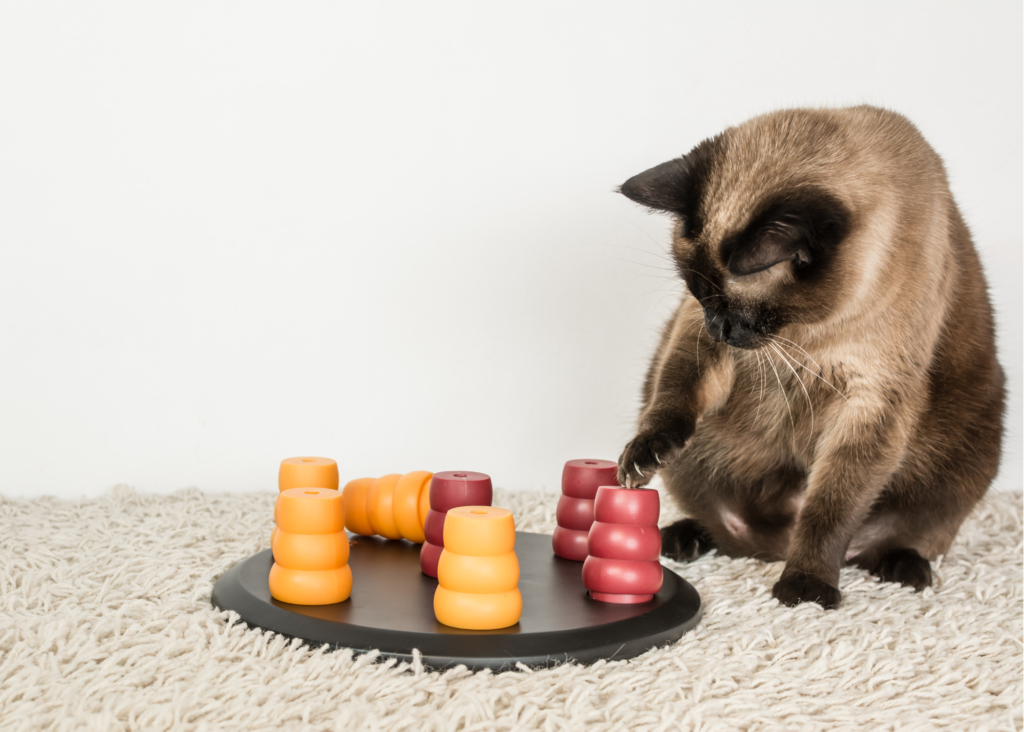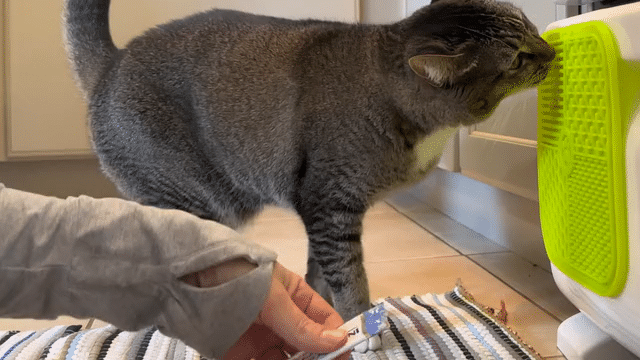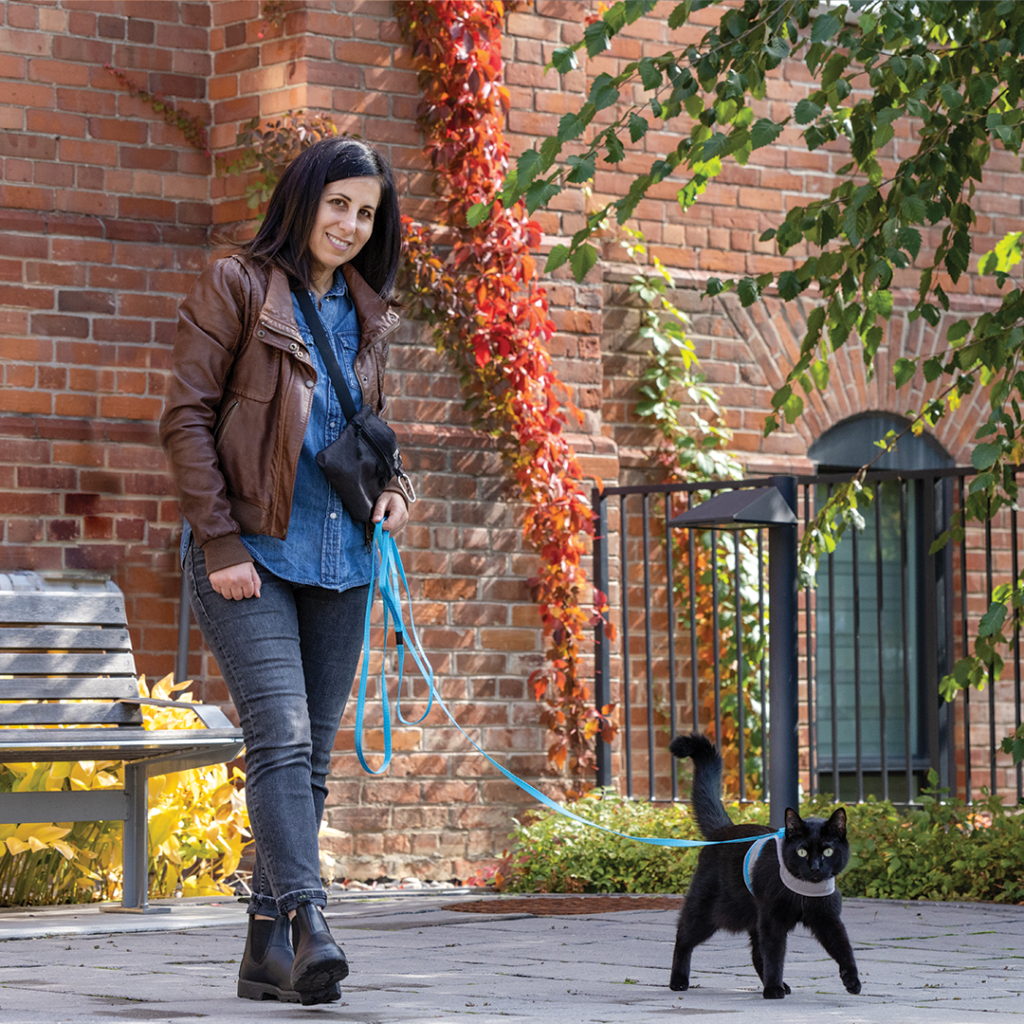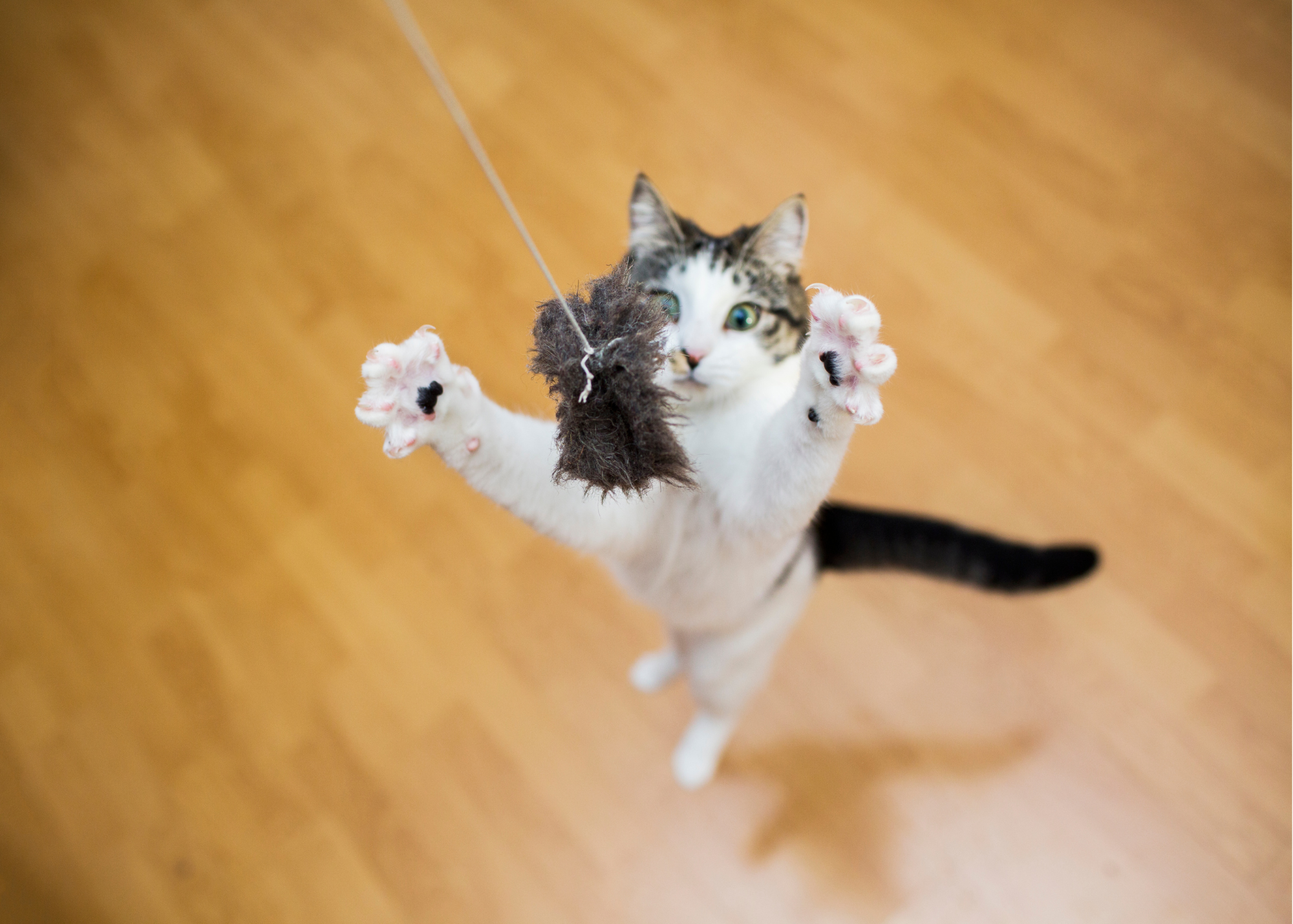Enrichment For Cats: 13 Ways to Improve Their Lives
We know that keeping cats indoors increases their safety and lifespan, but it does come at a cost: many indoor cats don’t get the mental and physical stimulation they need. The good news is there are many ways to provide enrichment for cats, even in a small space, and feline enrichment doesn’t have to be expensive or complicated. Check out our tips below to learn how to keep your feline friend happy and fulfilled.
Disclosure: Cat School may receive commissions from affiliate links included in this article.
What is Enrichment for Cats?
Enrichment is defined by the Oxford English Dictionary as “the action of improving or enhancing the quality or value of something.” When applied to cats, it means to improve or enhance the quality of their lives. Enrichment for cats is providing outlets for them to act on their natural instincts to run, climb, play, and hunt. It also means giving them activities that challenge them both mentally and physically.
Why is Enrichment for Cats Important?
Indoor cats are chronically bored. They are confined to their home, and their days are repetitive and endless, with nothing to do. Though we may think they’re living the life of luxury, getting to sleep all day without a care in the world, the reality is they are frequently bored and depressed.
“The lack of physical activity and mental stimulation that indoor cats must contend with day after day and year after year affects them more deeply than we could possibly understand,” a passage from the book Indoor Cat by Laura J. Moss and Dr. Lynn Bahr reads. “It takes a mental toll, often resulting in anxiety and depression. And it has physical effects as well, which can manifest as serious health ailments, such as skin conditions and gastrointestinal disorders.” So as you can see, not only is a bored cat affected mentally, they are also affected physically.
For indoor cats, stress has various health effects including the occurrence of obesity, type 2 diabetes, and chronic urinary tract infections.
In addition to helping combat these health issues, providing your cat with activity will give them an outlet to vent their excess energy, and it can also help with problem behaviors like aggression, litter box issues, and bullying. A bored cat can quickly become a destructive cat, after all.
By providing your cat with several types of enrichment to exercise both their body and mind, you are helping them to live their healthiest and best life. Not only that, the relationship and bond between you and your cat will become stronger than ever.

The Types of Cat Enrichment
Cat enrichment comes in many forms. There are games, cat toys, and enrichment activities you and your cat can do together, and others your cat can enjoy by themselves.
When coming up with enrichment ideas, be sure to consider all of your cat’s senses. They should have options to act on sight, smell, touch, hearing, and even taste. The good news is many enrichment ideas are simple and inexpensive, and many don’t even cost a thing.
Environmental Enrichment
Environmental enrichment for cats includes things that enhance your cat’s living quarters, allowing them to act on their natural instincts and desires. Here are several ways you can provide your cat with this type of enrichment:
- Grow some cat-friendly plants. Cats love greenery. They enjoy snacking on it, playing in it, and just enjoying the smells. You can create an indoor cat garden using cat-friendly plants, including cat grass, catnip, silvervine, spider plants, and impatiens. You can check the ASPCA Toxic & Non Toxic Plants List to find more cat-friendly plant options.
- Provide plenty of scratching surfaces. Cats have an innate need to stretch, flex, and scratch. Cat scratchers allow them to act on those instincts and needs without destroying your furniture. It’s best to have a variety of surfaces too – scratching posts, horizontal scratchers, scratchers made from sisal, and scratchers made from cardboard.
- Provide vertical space. Cats like to be up high, so it’s important to provide surfaces and space for them that allows them to climb up and get that bird’s eye view. Cat shelves on the wall or even a tall cat tree or other type of cat furniture will do the trick.
- Hang on to those cardboard boxes. It’s no secret that cats love boxes – even if those boxes sometimes seem too small for them to fit in. Boxes give them a place to hide, play, and even scratch and bite. The good news is they are easy to come by too!
Social Enrichment
Social enrichment involves activities you and your cat can enjoy together so they get socialization time and interaction with you (and even your family members and friends). This is beneficial for both of you, as it will help strengthen your bond.
- Play games with your cat. Games can be fun for all! They are a great way to engage with your cat while also getting them up and moving. Some games for a cat include dragging toys under blankets, towels or around corners; tossing cat treats for them to chase; or hiding and having your cat find you.
- Grab a wand toy. Wand toys are excellent interactive toys that give your cat the chance to chase, pounce, and “hunt” with you involved. You can run around the house with it, use it to encourage your cat to climb on their cat tree, and really get them active.
For more tips, check out this article about interactive cat play from Dr. Mikel Delgado.
Cognitive Enrichment
Cats need a mental workout in addition to a physical one. Cognitive enrichment provides just that. You might be surprised by how much a good mental workout will tire out your cat!
- Train with your cat. Clicker training requires your cat to problem solve while also increasing their movement, so it actually checks all the boxes for both a mental and physical workout. Plus, it’s an excellent bonding activity.
- Use food puzzles. Food puzzles or puzzle toys are toys that require your cat to manipulate it in some way to release food/treats as they interact with it. Some require your cat to roll it around until food comes out, and others require your cat to use their paws to move pieces around in order to access the food/treats. They are a great form of problem-solving, and they also satisfy a cat’s instinct to hunt and forage.
We recommend feeding your cat with food puzzles instead of bowl feedings twice a day as well. Check out Food Puzzles for Cats for more information about how you can use them to improve your cat’s life.
Sensory Enrichment
As mentioned, it’s important to give your cat the ability to exercise all their senses – sight, smell, touch, hearing, and even taste. Sensory enrichment activities do just that – they provide new and engaging sources of sensory exploration for your cat.
- Put your cat’s nose to the test. Nose work activities are when you hide treats or food for your cat to sniff out and forage. Examples of nose work activities include hiding treats in crumpled up paper or paper bags and placing them around a room, or filling plastic Easter eggs with treats for your cat to “hunt.” Snuffle mats are another more simple form of nose work. Checkout Nosework Cats for more information about this fun activity!
- Try a lick mat. A lick mat is a flat, rubber mat with ridges and bristles. You can spread your cat’s wet food or a Churu treat across it, and your cat has to lick around the mat to get the food. It’s a fun way to give your cat a special treat, and it can even help keep your cat happy and occupied for things like nail trims or flea and tick med application.
- Blow some bubbles. Bubbles floating through the air in their unpredictable flight patterns can be highly engaging and interesting for some cats. They enjoy jumping into the air after the bubbles and batting at (and popping) them. Just be sure whichever bubbles you use are cat-safe. There are actually even some companies that make catnip bubbles.
- Give your cat an interesting view. Got a window with a great view of the yard? Add a window perch and set up some bird feeders outside. Your cat will love getting to watch the birds. If your window has a screen, try opening it up so your cat not only gets a good show, they also get to hear and smell the birds too.
- Have a catnip party. While not all cats are affected by catnip, 70-80% are. You can throw your cat a catnip party by tossing out some catnip toys and/or sprinkling some catnip on a rug or cat bed. If your cat is one who enjoys the herb, they will have a blast smelling and rolling around in the nip. You can also try making your own DIY catnip socks!

Taking Your Cat Outside
For us humans, outdoor time has a multitude of benefits, including lower blood pressure, better mood, less anxiety, and more. “Clearly, access to the world outside the walls of our home is imperative to our mental and physical health. So it’s not surprising that the same holds true for our cats,” say Moss and Bahr in Indoor Cat.
Taking your cat on outdoor adventures actually checks all the boxes for feline enrichment. Not only does enjoying the great outdoors together strengthen your bond, it also allows your cat to experience so many new things they just don’t get inside. They will get to feel the grass beneath their paws (and maybe even enjoy a little nibble) and the breeze in their fur. Not to mention the countless sights, sounds, and smells.
Whether it’s back yard hangs or hikes in the woods, we would never recommend letting your cat free roam outdoors or leaving them outside unsupervised. For a safer outdoor experience, keep your cat on a harness and leash. Stroller and backpack rides are another safe alternative.
If you need help with cat harness and leash training, join Cat School for step-by-step training guidance, video tutorials, and personalized help from Julie the Cat Teacher.

Cat Enrichment FAQs
How long should I play with my cat every day?
Your cat should have access to toys they can play with themselves at all times, but you want to try to set aside 10-15 minutes each day for you to have interactive playtime with your cat. Some cats may need more play time than others or have different preferences, but ultimately we want our cats to get some physical activity each day.
How long should I train my cat every day?
Training with your cat doesn’t have to be time consuming. One or two 5-15 minute sessions each day would be a great addition to their routine! If you’re able to do more than that, great, but it isn’t necessary. You can even split up your training sessions throughout the day – a few minutes here and a few minutes there.
What if my cat doesn’t play?
Ensure that you are playing with your cat in a way that mimics how prey would behave; dangling a toy in front of your cat’s face won’t get them as excited as dragging toys under towels watching them disappear or around corners. Try to engage your cat in play before a meal when they are likely to be more active. If your cat is more motivated by food, consider practicing cat agility to increase your cat’s activity. You can guide your cat around an obstacle course using a little wet food on a spoon. This is an excellent way to burn physical and mental energy.
Fortunately, there are many ways to enrich an indoor cat’s life. Whether you engage your cat in a short play session, do training, or bring out their favorite food puzzle, your cat will appreciate you breaking up the monotony of their day, resulting in a happier and healthier companion.
Sources:
Dantas, L.M.S., Delgado, M.M., Johnson, I., & Buffington, C.A.T. (2016). Food puzzles for cats: Feeding for physical and emotional wellbeing. Journal of Feline Medicine and Surgery, 18(9), 723-732. https://doi.org/10.1177/1098612X16643753

